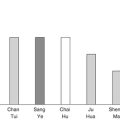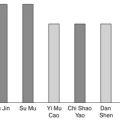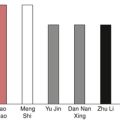Chapter Seven. Aromatic substances for transforming Dampness, for external application, and for opening the orifices
 |
1. What are the characteristics of the aromatic herbs and their usage?
Aromatic herbs have a very special function in transforming Dampness and breaking up the blockage of the Qi. They can penetrate into turbid Dampness because their light but sharp smells are able to separate the clean from the turbid. Meanwhile, their light but exceptional smell can wake up (stimulate) the internal organs that have been covered and confused by Dampness. The aromatic and pungent smells of these herbs can, on the one hand, stimulate the Spleen to transform Dampness and treat the causes of Dampness accumulation; on the other hand, they activate Qi movement so as to accelerate the functions of the involved organs.
In clinical practice, the aromatic herbs are often used to remove Dampness from the Middle Jiao, the Spleen and Stomach. They are also used for eliminating Dampness from the Liver and Gall Bladder as well as from the Heart. Some of them can open the orifices and treat ‘Lock-up syndrome’. They can also be applied topically to treat open wounds or trauma because they are able to transform the pus, dry Dampness, promote the movement of Qi and Blood, reduce swelling, stop pain and promote healing.
Although the functions of aromatic herbs are similar to those of the herbs that regulate the Qi, herbs that eliminate Dampness and herbs that clear Damp-Heat, they have their own specific characteristics and they do not fit easily into any of the herbal categories mentioned above. For this reason in many books they are included within the categories of herbs that aromatically transform Dampness, herbs that clear Summer-Heat, herbs that open the orifices and herbs for external usage.
2. What are the indications for and characteristics of the aromatic herbs that transform Dampness in the Middle Jiao?
Herbs that have an aromatic smell are able to transform turbid Dampness in the Middle Jiao and treat the syndrome of Dampness accumulation. This syndrome occurs in certain conditions. First of all, it happens when the Spleen is not able to transform Dampness in situations where there is Excessive-Dampness invasion or deficiency of the Spleen-Qi. Secondly, it can also happen when the Qi movement is disturbed in the Middle Jiao.
In this syndrome, Dampness as well as undigested food, Cold or Heat accumulate in the Middle Jiao and bring about symptoms and signs such as fullness in the chest, distension in the hypochondriac region and abdomen, a poor appetite, a sticky sensation in the mouth, nausea, vomiting, diarrhea or difficult defecation and heaviness of the body. Patients may have a thick, sticky, white or slightly yellow tongue coating and a moderate pulse.
In clinical practice, these herbs are usually used for Excessive syndromes—for example, Dampness invading the Middle Jiao caused by bad eating habits or consumption of unhygienic food, especially during a humid and hot summer. This syndrome can be seen in acute gastroenteritis, dysentery, hepatitis and gastric influenza. These herbs can also be used in Spleen-Qi deficiency syndrome such as in chronic hepatitis, hepatocirrhosis, cholecystitis and uremia, if combined with herbs that tonify the Spleen-Qi and regulate it.
There are many methods and herbs for treating Dampness: some herbs can drain out Dampness by promoting urination, some can dry Dampness directly and some can regulate the Qi to transform Dampness. The aromatic herbs that enter the Spleen and Stomach meridians can penetrate into turbid Dampness, wake up the Spleen which has been covered by Dampness, and stimulate the Spleen-Qi to transform Dampness as well as activating the Qi movement and therefore accelerating the process of transforming Dampness.
3. What are the differences between Huo Xiang ( Agastachis herba) and Pei Lan ( Eupatorii herba) in transforming Dampness and reviving the Spleen?
Huo Xiang and Pei Lan both are pungent and aromatic, and enter the Spleen and Stomach meridians. Both are able to transform Dampness in the Middle Jiao, revive the Spleen, improve the appetite and reduce fullness in the Stomach. They are especially often used to treat gastritis, hepatitis, cholecystitis and gastric influenza in the summer when the weather is humid and hot and the functions of Spleen and Stomach become weak.
Huo Xiang is slightly warm, aromatic and pungent. It can penetrate the turbidity and scatter the accumulation of Dampness and Heat. Its action is strong but not harsh and is particularly effective for regulating the Qi in the Middle Jiao, soothing the Stomach-Qi and treating nausea, vomiting and poor appetite.
Pei Lan is a neutral and gentle herb. Its light and fragrant smell can particularly separate the clean from the turbid in the Middle Jiao and revive the Spleen. It is effective for treating a sweet and sticky sensation in the mouth, or foul smell in the mouth, fullness in the chest, heavy limbs and a heavy sensation in the head. In Chinese, ‘ Pei’ means ‘wear’ or ‘ornament’; ‘ Lan’ means ‘orchid’. As Pei Lan has a nice smell, in ancient times it was often put in a small bag and carried by people under their clothes, like people use perfume nowadays.
4. Huo Xiang ( Agastachis herba), Pei Lan ( Eupatorii herba), Zi Su Ye ( Perillae folium) and Xiang Ru ( Moslae herba) are all able to disperse and transform Dampness and ease the Exterior. What are the differences between them?
These four herbs are aromatic and pungent and are able to expel Wind, Dampness and Summer-Heat, as well as transforming Dampness in the Middle Jiao. They are often used for treating abdominal influenza, acute gastritis and hepatitis accompanied by symptoms and signs such as fever, chills, headache and a heavy sensation in the head, fullness in the chest, gastric and hypochondriac regions, reduced appetite, nausea, vomiting, a thick and white tongue coating and a superficial and moderate pulse.
Of these four herbs, Xiang Ru is the warmest. It is able to induce sweating, disperse Wind and Dampness and release the Exterior. It is especially useful when fever, general pain and heaviness of the body are present but there is no sweating. This herb is also called Summer Ma Huang because it has a similar effect to Ma Huang ( Herba ephedrae) in inducing sweating, but is gentler. Xiang Ru is more suitable for use in the summer, when the pores are not closed so tightly as in winter. It has also the function of transforming Dampness in the Middle Jiao and treating abdominal pain, vomiting, diarrhea and edema, but its action is not as strong as that of the other three herbs.
Zi Su Ye is a light and aromatic herb. Since it is less warm and pungent than Xiang Ru, it is not able to induce sweating and disperse Dampness. However, it can gently disperse and expel Wind-Cold in the superficial layer of the body and release the Exterior. It can also stop nausea by soothing the Stomach-Qi. It is an ideal herb for alleviating morning sickness and uneasy sensations in the body during early pregnancy because it can harmonize the Qi in the Nutritive and Defensive levels of the body and soothe the Stomach-Qi, and its action is limited to the Upper Jiao and Middle Jiao.
Huo Xiang is an excellent herb for expelling Wind, Cold and Dampness and can also transform Dampness in the Middle Jiao. Compared with Xiang Ru, its action is stronger in transforming Dampness in the Middle Jiao; compared with Zi Su Ye, it not only expels Wind and Cold, but also disperses Dampness in the superficial layers of the body. This is the most commonly used herb for treating cold and influenza infections and acute gastritis, especially in the summer.
Pei Lan is the weakest of the herbs for releasing the Exterior, but it is the strongest in terms of penetrating into the turbidity to separate and transform Dampness. It revives the Spleen and therefore it treats Qi stagnation caused by Dampness. It is especially effective for treating a sticky sensation in the mouth and foul and unpleasant sweet tastes in the mouth, as well as fullness in the chest and gastric region.
5. What are the differences between the functions of Sha Ren ( Amomi xanthioidis fructus), Bai Dou Kou ( Amomi fructus rotundus), Cao Dou Kou ( Alpiniae katsumadai semen) and Cao Guo ( Tsaoko fructus)?
These four herbs are all aromatic herbs. They are pungent and warm, and enter the Spleen and Stomach meridians. They are able to transform turbid Dampness, regulate the Qi and revive the Spleen. However, the strength of each of the four herbs is different and each also has its own characteristics.
For regulating the Qi in the Middle Jiao and reducing distension and nausea, as well as alleviating pain in the abdomen, Sha Ren is the strongest of the herbs, followed by Bai Dou Kou, then Cao Dou Kou and finally Cao Guo.
For transforming turbid Dampness, warming the Middle Jiao and treating symptoms such as abdominal pain, preference for warm compresses and drinks, vomiting clear water and diarrhea, Cao Guo is the strongest of the herbs, followed by Cao Dou Kou, then Bai Dou Kou and finally Sha Ren.
As well as these differences, Sha Ren is also able to relieve nausea and calm the fetus and so is used in pregnancy; Bai Dou Kou is particularly good at improving the appetite and reducing distension; Cao Dou Kou can warm and strengthen the Spleen and Cao Guo is used to treat malaria.
6. Which herbs can aromatically transform Dampness from the Liver and Gall Bladder and what are the symptoms in this syndrome?
The herbs that aromatically transform dampness from the Liver and Gall Bladder are Cao Guo ( Tsaoko fructus), Qing Hao ( Artemisiae annuae herba), Yu Jin ( Curcumae radix) and Yin Chen Hao ( Artemisiae scopariae herba).
These herbs treat the syndrome of Damp-Heat accumulating in the Middle Jiao and obstructing the secretion of bile. Besides the several symptoms of Dampness accumulation in the Middle Jiao, there may also be jaundice, a bitter taste and sticky sensation in the mouth, irritability, tiredness and heaviness of the body. This syndrome can be found in acute hepatitis, cholecystolithiasis, chronic cholecystitis and malaria. Of these four herbs, Cao Guo and Qing Hao are used in the treatment of malaria, whereas Yu Jin and Yi Chen Hao are used to treat hepatitis and cholecystitis.
7. Which herbs can aromatically eliminate Damp-Phlegm from the Heart and what are the symptoms in this syndrome?
The herbs that can aromatically remove Damp-Phlegm from the Heart are Shi Chang Pu ( Acori graminei rhizoma) and Yu Jin ( Curcumae radix).
They are used for treating disorders such as poor memory, inability to concentrate, inability to study and mental confusion due to Damp-Phlegm covering the Mind. In this condition, the tongue coating is white and sticky and the pulse is slippery. In order to achieve a better therapeutic effect, these herbs are often combined with other herbs that transform Phlegm and regulate the Qi, such as Yuan Zhi ( Polygalae radix), Zhu Ru ( Bambusae caulis in taeniam), Zhi Ke ( Aurantii fructus) and Chen Pi ( Citri reticulatae pericarpium).
8. Which aromatic herbs are used externally and what are the indications for use?
The aromatic herbs for external usage are Ru Xiang ( Olibanum), Yu Jin ( Curcumae radix), Bing Pian ( Borneol), Qiang Huo ( Notopterygii rhizoma), Xi Xin ( Asari herba)*, Bai Zhi ( Angelicae dahuricae radix), Rou Gui ( Cinnamomi cassiae cortex) and She Xiang ( Moschus)**.
These herbs are usually used in herbal plasters, lotions, pastes or powders. All of them can penetrate the muscles, promote the Qi and Blood circulation, reduce swelling and relieve pain. They are used in the treatment of acute and chronic trauma, strains and open wounds.
Of these herbs, synthetic She Xiang, Bing Pian and Rou Gui can strongly break up the obstructions, reduce swelling and stop pain; Rou Xiang and Yu Jin can effectively promote Blood circulation and relax the muscles; Qiang Huo and Xi Xin can expel Wind-Damp-Cold from the muscles; Bai Zhi can transform Dampness and can be applied to open wounds to promote healing.
In acute infections, these herbs are used together with herbs that reduce Heat-toxin; in conditions of chronic strain, they are used with herbs that open up the collaterals; to treat Bi syndrome, they are used with herbs that expel Wind, Dampness and Cold. These aromatic herbs are also often used externally with herbs that promote Blood circulation. In conditions where there is bleeding or fracture, the herbs should be applied after the bleeding and fractures are corrected.
9. What is Locked-up syndrome?
Locked-up syndrome is an acute, severe and Excess syndrome which may occur alone or develop from severe disease. The pathological change is sudden disturbance of Qi and Blood, and blockage both of the sensory orifices and of the associations of the internal organs by rebellious Qi, Blood, Phlegm or uprising Yang. Symptoms in this syndrome show obvious signs of blockage of the orifices and a locked-up body, such as loss of consciousness, lockjaw, clenched fists, rigid limbs and lack of urination and bowel movement. In Locked-up syndrome caused by Heat, there are also high fever, irritability, a red face, heavy breath and warm limbs, a yellow, thick tongue coating and a rapid, slippery, forceful pulse. If the Locked-up syndrome is caused by Cold, there are cold limbs, a pale complexion, a white, thick tongue coating and a deep, wiry pulse.
In clinical practice, this syndrome can be found in severe infection, cerebrovascular accident, hepatic coma, uremia, sunstroke, syncope, lightning stroke, drowning and hysteria.
10. Locked-up syndrome and Collapsing syndrome can both occur in coma. What are the differences in the symptoms and the pathological changes between the two syndromes?
In clinical practice, coma may occur in the process of severe diseases such as severe infections, cerebrovascular accident, myocardial infarction, hepatic coma, uremia, loss of a large amount of blood, lightning stroke and drowning. Since these patients have lost consciousness, it is important to make a correct differentiation of the syndrome by observation and palpations before treatment.
Locked-up syndrome is an acute Excess syndrome. The orifices are locked up by disturbance of the Qi and Blood, which are complicated with Phlegm, Heat or Cold, as well as uprising Yang. The symptoms are loss of consciousness, lockjaw, clenched fists, rigid limbs and a wiry, slippery and forceful pulse. The syndrome is seen mainly in cerebrovascular accident, epilepsy, sunstroke, hysteria, severe pain, allergy, syncope, hepatic coma and uremia. Treatment should be given to open the orifices, expel Phlegm, clear Heat or warm the internal Cold and to harmonize the Qi and Blood.
Collapsing syndrome is a Deficiency syndrome. It is caused by disharmony of the Yin, Yang, Qi and Blood when the Yang and Qi are too weak to hold the Yin and the Blood and to carry on the functions of the internal organs. In this syndrome, patients lose consciousness gradually and they have shallow respiration, shortness of breath, cold limbs, profuse sweating and incontinence of urine. The pulse is very deep and weak. This syndrome occurs in conditions where patients lose a large amount of blood, in severe dehydration, in myocardial infarction and in severe infections. The treatment should be given to strengthen the Qi strongly, and to rescue the Yang. After the patient recovers consciousness, the treatment of tonifying the weakness and harmonizing the functions of the internal organs should start.
11. What are the characteristics of the herbs that open the orifices and what precautions should be observed when they are used?
The substances that open the orifices are used for treating Locked-up syndrome, a severe, acute, Excess syndrome. These substances are very pungent, have strong aromatic smells, move quickly and are able to penetrate the body, break up blockage and revive the Spirit. If combined with other herbs that expel Phlegm, eliminate Heat-toxin or Cold turbidity, they can open the orifices in a very short time. From the viewpoint of Western medicine, these substances are able to stimulate the central nervous system, the peripheral nervous system and the heart, irritate the respiratory mucosa and smooth the muscles.
Since the aromatic components are the main part of substances that open the orifices, and since they are easily destroyed by high temperatures during cooking, substances for opening the orifices are always prepared at low temperature and are often combined with other herbs that eliminate Phlegm, reduce poison and harmonize the Qi and Blood. Some substances such as She Xiang ( Moschus)** and Niu Huang ( Bovis calculus)** are substituted by the synthetic versions.
Since Locked-up syndrome is subdivided into Hot Locked-up syndrome and Cold Locked-up syndrome, the substances are also divided into two groups, cold and warm.
The cold substances are used for Hot Locked-up syndrome. They are synthetic Niu Huang ( Bovis calculus), Bing Pian ( Borneol), Yu Jin ( Curcumae radix) and Lian Qiao ( Forsythiae fructus).
The warm substances are used for Cold Locked-up syndrome. They are synthetic She Xiang ( Moschus), Su He Xiang ( Styrax), An Xi Xiang ( Benzoinum), Shi Chang Pu ( Acori graminei rhizoma), Huo Xiang ( Agastachis herba) and Pei Lan ( Eupatorii herba).
Although these aromatic substances are very necessary for use in acute conditions, even so they should be used with caution. Because these aromatic substances are able to break up the blockage of the orifices and stimulate the Yin, Yang, Qi and Blood, they may scatter and weaken the Qi, so should be used for only a short period of time. After patients are revived from coma, treatment should be given according to the differentiation of the syndrome at that moment. In addition, these substances should not be used in pregnant women, in conditions of heavy bleeding, or during coma in a Collapsing syndrome.
Comparisons of strength and temperature in aromatic substances that transform Dampness, that are for external application and that open the orifices
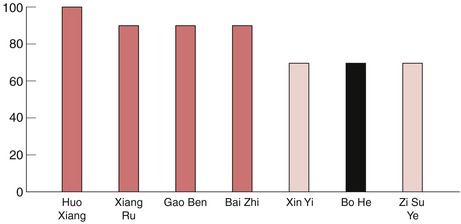 |
| Fig. 7.1. |
| Comparison of the herbs that aromatically transform turbid Dampness and release the Exterior. Huo Xiang ( Agastachis herba), Xiang Ru ( Moslae herba), Gao Ben ( Ligustici sinensis radix), Bai Zhi ( Angelicae dahuricae radix), Xin Yi ( Magnoliae flos), Bo He ( Menthae herba), Zi Su Ye ( Perillae folium). |
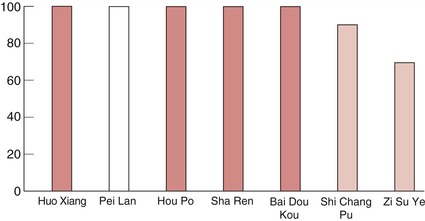 |
| Fig. 7.2. |
| Comparison of the herbs that aromatically transform Dampness from the Middle Jiao. Huo Xiang ( Agastachis herba), Pei Lan ( Eupatorii herba), Hou Po ( Magnoliae cortex), Sha Ren ( Amomi xanthioidis fructus), Bai Dou Kou ( Amomi fructus rotundus), Shi Chang Pu ( Acori graminei rhizoma), Zi Su Ye ( Perillae folium). |
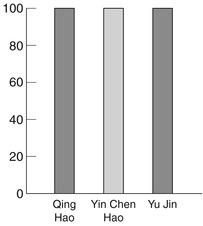 |
| Fig. 7.3. |
| Comparison of the herbs that aromatically transform Dampness from the Liver and Gall Bladder. Qing Hao ( Artemisiae annuae herba), Yin Chen Hao ( Artemisiae scopariae herba), Yu Jin ( Curcumae radix). |
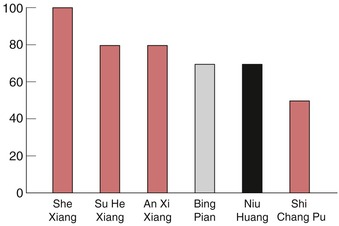 |
| Fig. 7.4. |
| Comparison of the substances that aromatically open the orifices. She Xiang ( Moschus)**, Su He Xiang ( Styrax), An Xi Xiang ( Benzoinum), Bing Pian ( Borneol), Niu Huang ( Bovis calculus)**, Shi Chang Pu ( Acori graminei rhizoma). |
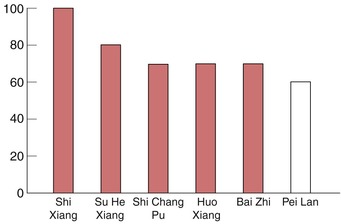 |
| Fig. 7.5. |
| Comparison of the herbs that aromatically transform turbid Dampness. She Xiang ( Moschus)**, Su He Xiang ( Styrax), Shi Chang Pu ( Acori graminei rhizoma), Huo Xiang ( Agastachis herba), Bai Zhi ( Angelicae dahuricae radix), Pei Lan ( Eupatorii herba). |
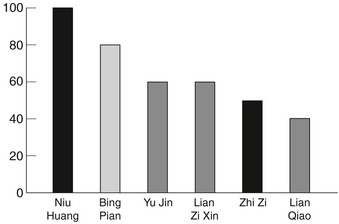 |
| Fig. 7.6. |
| Comparison of the herbs that clear Heat-toxin and open the orifices. Niu Huang ( Bovis calculus)**, Bing Pian ( Borneol), Yu Jin ( Curcumae radix), Lian Zi Xin ( Nelumbinis plumula), Zhi Zi ( Gardeniae fructus), Lian Qiao ( Forsythiae fructus). |
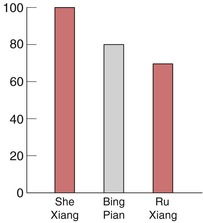 |
| Fig. 7.7. |
| Comparison of the substances that aromatically reduce swelling and stop pain. She Xiang ( Moschus)**, Bing Pian ( Borneol), Ru Xiang ( Olibanum). |
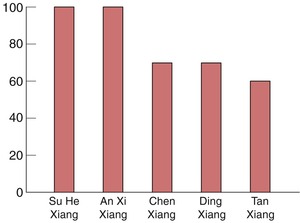 |
| Fig. 7.8. |
| Comparison of the substances that aromatically open the orifices, regulate the Qi and relieve pain. Su He Xiang ( Styrax), An Xi Xiang ( Benzoinum), Chen Xiang ( Aquilariae lignum), Ding Xiang ( Caryophylli flos), Tan Xiang ( Santali albi lignum). |

